Plate lifting magnets significantly advance the handling and transporting of ferrous materials in various industrial settings. These devices utilize magnetic power to securely attach and lift heavy metal objects, mainly steel plates, providing a more efficient and safer alternative to traditional lifting methods like chains, hooks, or clamps.
How Plate Lifting Magnets Operate
Magnetic properties and materials, activation mechanisms, and safety and reliability features are all important facets of plate lifting magnets' comprehensive functionality. Each aspect ensures these devices operate efficiently, maintain robust safety standards, and adapt seamlessly to various industrial environments. These components come together to create a reliable and effective lifting solution that significantly enhances the handling of heavy ferrous materials.
Three Main Components of Plate Lifting Magnets
- Magnetic Properties and Materials: Plate lifting magnets typically employ rare-earth metals such as neodymium or ferrite. These materials are known for their strong magnetic properties and ability to create a powerful magnetic field with high durability and stability. The design involves a permanent magnet system that can be activated or deactivated mechanically, allowing the magnet to lift or release the load as required.
- Activation Mechanism: The core mechanism behind plate lifting magnets involves shifting the magnetic field to engage or disengage the load. This is often achieved using a lever or an electronic switch that alters the alignment of internal magnets, changing the magnetic field's effect from attractive to neutral. This method ensures that the magnet can securely hold the steel plate when activated and easily release it at the desired location without requiring external power.
- Safety and Reliability: Plate lifting magnets' inherent safety features are a critical advantage. Since the lifting process is controlled magnetically, there is a reduced risk of accidents common with hooks and chains. Additionally, these magnets are designed with fail-safe features that ensure the load is not dropped unexpectedly, which is crucial in maintaining workplace safety.
Advantages of Using Plate Lifting Magnets
- Enhanced Efficiency: Plate lifting magnets streamline operations by reducing the time and labor required to attach and detach loads. Unlike manual hooking or clamping, a single individual can operate a magnetic lifter and quickly attach to or release a steel plate.
- Improved Workplace Safety: Plate lifting magnets reduce injuries related to handling heavy objects by eliminating the need for manual securing of loads. The secure magnetic hold also minimizes the chances of dropping the load, enhancing workers' safety and the work environment.
- Cost Effectiveness: Plate lifting magnets require minimal maintenance and no external power, making them a cost-effective solution for moving heavy ferrous materials. Their durability and reliability mean fewer replacements and repairs, leading to long-term savings in equipment costs.
- Versatility: These magnets can be used in various settings, including warehouses, fabrication shops, shipyards, and construction sites. They can handle different sizes and weights of steel plates, providing flexibility in operation.
Could You Benefit from Plate Lifting Magnets?
Permadur offers various lifting magnet models to accommodate different operational needs, ensuring every business can find a suitable solution. We encourage you to reach out if you are considering the advantages of magnetic lifting technology for your operations. Our team is ready to help you assess your needs and select the perfect type of plate lifting magnet for your specific applications.


